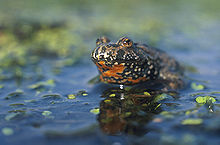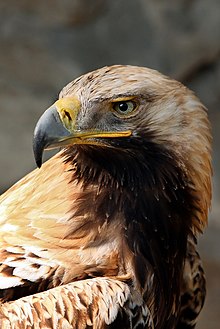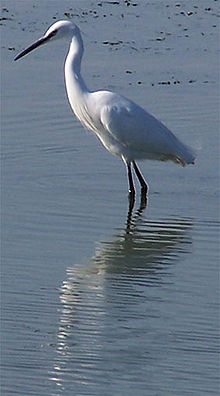March-Thaya-Auen European Protected Areas
Coordinates: 48 ° 19 ′ 48 ″ N , 16 ° 52 ′ 5 ″ E
The Natura 2000 - European Protected Areas March-Thaya-Auen are formed from an FFH area (AT1202000) and a European bird sanctuary (AT1202V00) in the main region of Weinviertel in Lower Austria .
location
The wetlands of the lowland rivers March and Thaya are surrounded by extensive grassland areas on the borders of Austria to Slovakia and the Czech Republic. Flood events occur regularly, especially in spring . The area is in the districts of Gänserndorf and Mistelbach in the communities Altlichtenwarth , Angern an der March , Bernhardsthal , Drösing , Dürnkrut , Engelhartstetten , Hausbrunn , Hohenau an der March , Jedenspeigen , Lassee , Marchegg , Rabensburg , Ringelsdorf-Niederabsdorf and Weiden an der March .
The area of Community importance (GGB / SCI, FFH area) has a size of approx. 8880 ha, the larger bird sanctuary (Special Protection Area, BSG / SPA) comprises 14,834 ha - the FFH area is largely within the bird sanctuary the Natura 2000 area 15,086 ha.
According to the nature conservation concept of Lower Austria, the area runs through the regions 08 Northeast Weinviertel, 10 Southeast Weinviertel and 11 Donau-March-Thayaauen and Marchfeld.
Legal basis
Natura 2000 network
The legal basis for the area are the Habitats Directive of the European Union and ordinances of the Lower Austrian provincial government. A joint management plan was drawn up for both areas.
Other protected areas
It is also one of the most important migration, resting and guest bird areas in Austria. As a result, the area is also classified as an Important Bird Area ( AT010 , criterion B2), but with 131,535 hectares, it is also partly in the Donau-Auen National Park . There is also the European protected area Donau-Auen east of Vienna ( AT1204000 ) with 9,579 ha.
- It is also located in the Austrian Danube – March – Thaya-Auen area , designated according to the Ramsar Convention , which stretches 385 km² from Vienna down the Danube and along the March and Thaya, and together with the Ramsar areas of Untere Lobau ( No. 273 ), Mokrady dolního Podyjí ( no. 635 ) in the Czech Republic and Moravské luhy ( no. 604 ) in Slovakia form the trilateral Ramsar floodplains at the confluence of the Morava , Thaya and Danube rivers ( English Floodplains of the Morava – Dyje – Danube Confluence ) - that worldwide only three-country Ramsar area.
- Furthermore, the area is designated as the Lower Austrian protected landscape area Donau-March-Thaya-Auen ( No. 20 , 205 km²), also from the borders of Vienna via the Hungarian-Slovakian triangle to the Czech border.
The nature reserves are located within the Natura 2000 area :
- Untere Marchauen ( No. 8 , 1,223 ha) / WWF Nature Reserve Marchegg
- Rabensburger Thaya-Auen ( No. 37 , 385 ha)
- Angerner and Dürnkruter Marchschlingen ( No. 39 , 81 ha)
- Kleiner Breitensee ( No. 23 , 44.5 ha)
- Salt steppe Baumgarten an der March ( No. 12 , 11.6 ha)
The WWF calls for the establishment of its own national park in order to give this natural area an IUCN Category 2 status.
The recognition as a biosphere reserve of UNESCO is the BMLFUW sought. Cross-border with the Czech Republic and Slovakia, which has proven so successful with Hungary in the neighboring area of Lake Neusiedl , is being considered. This would result in a Europe-wide unique protection network in the Austrian Wetlands Strategy, which would also implement the “ Europe of the Regions ” idea of the Centrope project in environmental protection and cover the entire transition area of the Eastern Alps - Pannonian Plain - Bohemian Massif.
Flora, fauna and habitats
Habitats
The following significant habitat types of Community interest are located in the FFH area ; priority habitat types are marked with *.
| Natura 2000 code | Habitat type |
|---|---|
| 1530 * | Halophilic Pannonian habitats |
| 2340 * | Pannonian inland dunes |
| 3130 | Mud flats |
| 3150 | Natural standing waters with floating bodies |
| 3270 | Two-tooth corridors of muddy banks |
| 6240 * | Eastern European steppes |
| 6250 * | Deep dry loess grass |
| 6440 | Burning cones floodplain meadows |
| 6510 | Smooth oat meadows |
| 9160 | Central European and Illyrian humid oak and hornbeam forest |
| 91E0 * | Alder-ash-willow meadows |
| 91F0 | Oak-elm-ash floodplains |
| 91G0 | Pannonian oak-hornbeam forests |
animals and plants
The area is the habitat of the following species that are listed in Appendix II of the Habitats Directive; priority species are marked with *.
| Natura 2000 code | Art |
|---|---|
| VERTEBRATES | |
| Mammals | |
| 1335 | European ground squirrel |
| 1337 | beaver |
| 1355 | Otter |
| Bats | |
| 1324 | Great mouse ear |
| Amphibians | |
| 1188 | Fire-bellied toad , lowland toad |
| 1993 | Danube crested newt |
| Reptiles | |
| 1220 | European pond turtle |
| Fish and lampreys | |
| 1114 | Female nerfling |
| 1124 | White fin gudgeon |
| 1130 | Rapfen , Schied |
| 1134 | Bitterling |
| 1145 | Mud whip |
| 1149 | Wolffish |
| 1157 | Schrätzer |
| 1159 | Zingel |
| 1160 | nerd |
| INVERTEBRATE | |
| Beetle | |
| 1083 | Stag beetle |
| 1086 | Scarlet beetle |
| 1088 | Big oak buck |
| Butterflies | |
| 1059 | Light blue ant bluebird |
| 1060 | Big fire butterfly |
| 1061 | Dark blue ant bluebird |
| 1074 | Hedge wool jack |
| Dragonflies | |
| 1037 | Green maidenhead |
| Shellfish | |
| 1032 | Common river mussel |
49 significant bird species in Appendix I of the Birds Directive give the area great importance among the Austrian wetlands.
| Natura 2000 code | Art |
|---|---|
| A021 | bittern |
| A022 | Little bittern |
| A023 | Night heron |
| A026 | Little Egret |
| A027 | Great Egret |
| A029 | Purple heron |
| A030 | Black stork |
| A031 | White stork |
| A034 | Spoonbill |
| A060 | Bog duck |
| A068 | Dwarf slayer |
| A072 | Honey buzzard |
| A073 | Black kite |
| A074 | Red kite |
| A075 | White-tailed eagle |
| A081 | Marsh harrier |
| A082 | Hen harrier |
| A084 | Montagu's Harrier |
| A089 | Lesser Spotted Eagle |
| A094 | Osprey |
| A098 | Merlin |
| A103 | Peregrine falcon |
| A119 | Spotted Moorhen |
| A120 | Little Moorhen |
| A122 | Corn Crake |
| A127 | crane |
| A131 | Stilt |
| A140 | Golden plover |
| A151 | Ruff |
| A166 | Wood sandpiper |
| A190 | Predatory tern |
| A193 | Common tern |
| A196 | Whitebeared tern |
| A197 | Black Tern |
| A215 | Eagle owl |
| A222 | Short-eared Owl |
| A224 | Goat milker |
| A229 | kingfisher |
| A234 | Gray woodpecker |
| A236 | Black woodpecker |
| A238 | Middle woodpecker |
| A246 | Woodlark |
| A255 | Brachieper |
| A272 | Bluethroat |
| A307 | Sparrowhawk Warbler |
| A321 | Collar snapper |
| A338 | Red backs |
| A404 | Imperial eagle |
| A429 | Blood woodpecker |
Conservation goals
The conservation objectives of the European protected areas are defined in the management plan. This includes, among other things, the maintenance or restoration of a sufficient extent of near-natural river sections, continuous river and eye water systems as well as small and micro bodies of water for fish populations. In addition to set-aside or fallow areas in open land dominated by agriculture, large open water areas are also to be preserved. Further goals are the preservation of near-natural stands of alluvial forest, dead wood, wet meadows and floodplains and sand habitats. There is also to be support for structurally rich cultural landscapes adjacent to the alluvial forest.
literature
- Flowing borders. March-Thaya floodplain habitat . Federal Environment Agency, Vienna 1999, ISBN 3-85457-487-8 .
Web links
- Brochure (PDF)
- Area description (PDF; 790 kB)
- Standard data sheet AT1202000
- Standard data sheet AT1202V00
Individual evidence
- ↑ Lower Austria nature conservation concept. Office of the Lower Austrian State Government, 2015, accessed on August 9, 2018 .
- ↑ Ordinance on the notified areas of Community importance ( page no longer available , search in web archives ) Info: The link was automatically marked as defective. Please check the link according to the instructions and then remove this notice. , August 20, 2004
- ↑ Regulation on the European Protected Areas ( page no longer available , search in web archives ) Info: The link was automatically marked as defective. Please check the link according to the instructions and then remove this notice. , March 5, 2010
- ↑ BirdLife International (2017) Important Bird Areas factsheet: March / Thaya riverine forest. Retrieved September 20, 2017 .
- ↑ Umweltbundesamt (Ed.): Ramsar in Austria . Information from the federal states and the Ministry of Life. S. 7 ( pdf, 2.6 MB , Umweltbundesamt.at). pdf, 2.6 MB ( Memento of the original from September 17, 2011 in the Internet Archive ) Info: The archive link was inserted automatically and has not yet been checked. Please check the original and archive link according to the instructions and then remove this notice.
- ^ Transboundary Ramsar sites. In: ramsar.org> Documents. November 16, 2009, accessed June 2010 .
- ↑ WWF on National Park Strategy : Time is ripe for Austria's 7th National Park - March-Thaya-Auen must be protected. In: OTS press service. WWF Austria, June 21, 2010, accessed June 21, 2010 (OTS0111).
- ↑ https://www.bmlfuw.gv.at/umwelt/natur-artenschutz/feuchtgebiete/ramsar/donaumarchauen.html
- ↑ cf. Irene Oberleitner: Austrian wetland strategy. Targets and measures 2006–2010 . On behalf of the Ministry of Life, Dept. II / 4. Ed .: Federal Environment Agency. Vienna 2006 ( Online PDF 0.5 MB). Online ( Memento of the original from March 4, 2016 in the Internet Archive ) Info: The archive link was inserted automatically and has not yet been checked. Please check the original and archive link according to the instructions and then remove this notice.
- ^ Province of Lower Austria: Important conservation goals and measures










